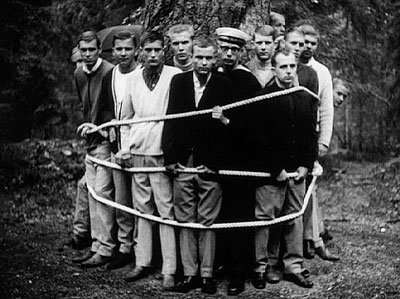Flaubert, Gustave. Madame Bovary (1857). New York: Signet Classics, 19??.
 The way I see it, my sympathies are with Charles, all the way. You probably know this story—Emma Bovary marries Charles, a provincial "doctor" (he doesn't have a medical degree), and very quickly becomes unhappy and unsatisfied, so she takes on a string of lovers and a lot of debt and eventually commits suicide to end the unhappiness in her life; this affects Charles drastically—and maybe you didn't know the end but there it is. And I know about how Flaubert isn't trying to write toward a subject or a moral or a meaning, he simply wants to present things as they are in life, but I think I'm right in his wanting us to feel for Charles in the end. Why else open the novel with him, and close it with his death?
The way I see it, my sympathies are with Charles, all the way. You probably know this story—Emma Bovary marries Charles, a provincial "doctor" (he doesn't have a medical degree), and very quickly becomes unhappy and unsatisfied, so she takes on a string of lovers and a lot of debt and eventually commits suicide to end the unhappiness in her life; this affects Charles drastically—and maybe you didn't know the end but there it is. And I know about how Flaubert isn't trying to write toward a subject or a moral or a meaning, he simply wants to present things as they are in life, but I think I'm right in his wanting us to feel for Charles in the end. Why else open the novel with him, and close it with his death?If you're at all interested in the novel as form, you have to read this book right away. The story itself is pretty banal (Flaubert dealing quite deliberately and explicitly with mediocre people; indeed, the life of mediocrity maybe be his true subject here), but what's amazing is the way he shifts point of view from one character to the next so smoothly. This happens on a "macro level", in how we open from the point of view of one of Charles's classmates, then move to a classic 19thC omniscient narrator, then into Charles's point of view when he's an adult, and then, only after he marries one woman (who dies) and then marries Emma do we gradually move to her point of view for much of the rest of the novel (until of course she dies, which death, I'm pretty sure, is narrated from a distant POV).
But it's on the micro level (i.e., within paragraphs) that the effect is truly stunning. I don't have a copy of the book with me to give you an exemplary passage, but read Rousset's "Madame Bovary: Flaubert's Anti-Novel" to get an idea of what I'm talking about.
Or just read the book. Today.


1 Comments:
I love this book but couldn't finish it this time around. Too many associated memories.
As for the story, as far as I know from a layman's point of view, the French writers of the 19th century were obsessed with documenting reality in all its banality. Balzac, for example.
The shifting narrator is very well done even with the horrible translation I have. I'm sure it's pretty amazing if you can read French.h
Post a Comment
<< Home